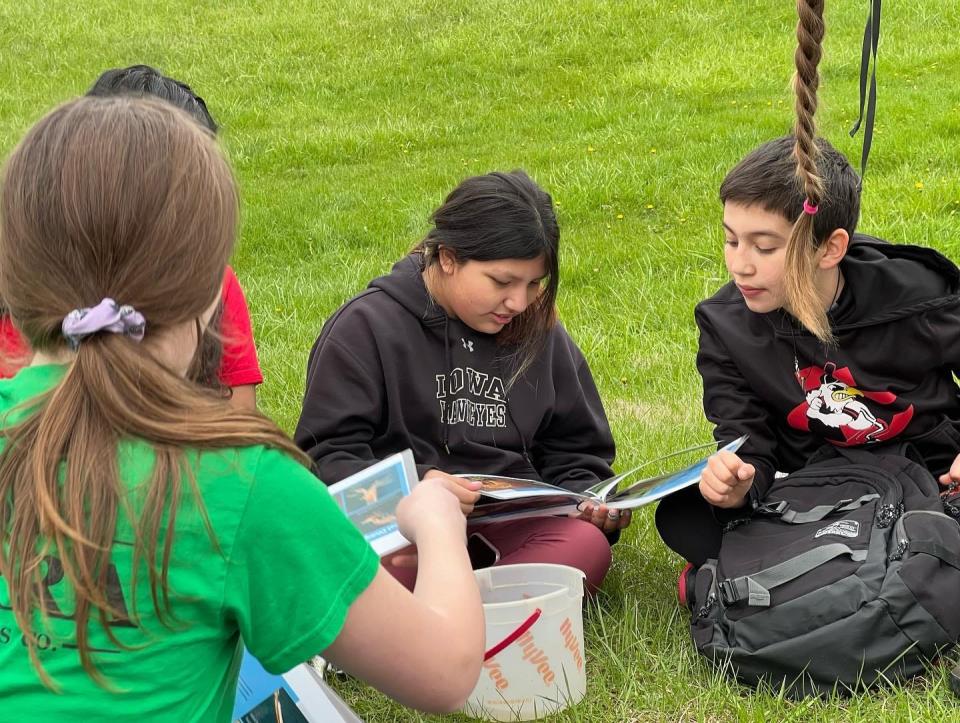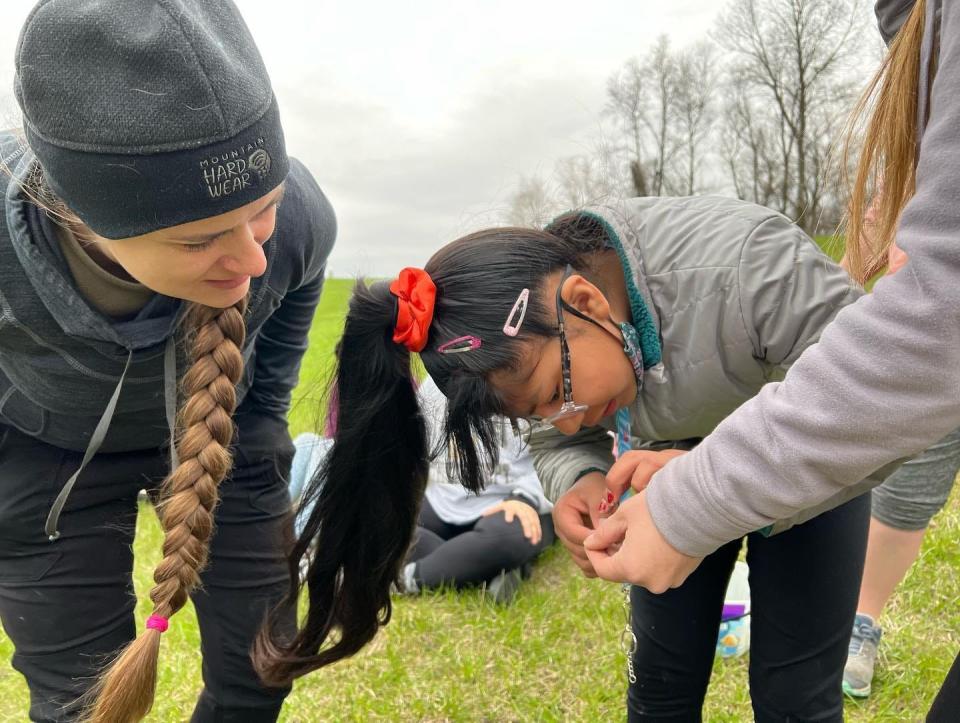'Youth have stories to tell': Iowa City fifth-graders write about the environment in new program
At the edge of the pond at Cangleska Wakan in Solon, a group of fifth-graders huddled around a bucket, peering at the different critters and shells they’d scooped from the water.
Moments earlier, another student found success when he dipped his net into the pond.
“I got a tadpole,” he shouted, carrying his find back to his bucket.
The students were from Alexander Elementary in Iowa City, tasked with exploring the wetlands on a field trip in early May.
Before the activity, a Johnson County Conservation educator asked students what they might find in the wetland.
“An alligator.”
“Snakes.”
“Turtles.”
“Trash.”
A couple of falls into the shallow water and one bucket of 23 tadpoles later, the children sat on the grass and pulled out notebooks.
They were asked to choose one plant or animal to write or draw about.
“A caterpillar is an animal in the water,” one student wrote.
“I was so glad to see them,” another student wrote about the animals.
The field trip was a culmination of two in-class guest speakers discussing the environment and the natural world. It was part of the Iowa Youth Writing Project’s new program, Writing on the Environment, which invited students to write about the subject through lessons and exploration.
IYWP partnered with three Iowa City Community School District elementaries: Alexander, Hills and Mark Twain.
On Saturday, students and their families have been invited back to Cangleska Wakan for a dinner. Some students will read their work there. It will be printed on yard signs displayed temporarily at the park for community members to view.
Student work will also be published in an anthology to give to students, schools and community partners.
“The project is really an opportunity to celebrate youth voices and their power and ability to really make a difference for our climate crisis and … our environment and natural world,” Michelle Wiegand, former IYWP associate director, said to the Press-Citizen.
‘Students can advocate for themselves and for their community by writing about it’
Last fall, Wiegand reached out to Patrick Snyder, elementary science and social studies coordinator at ICCSD.
IWYP’s Writing on the Environment program proved to be a good fit for fifth-grade students.
Snyder said that, when a school can take what is being taught inside a classroom and connect it to an outdoor space, that is more valuable and empowering for students.
Part of the science instruction throughout the year and during the time of the Writing on the Environment program was about living systems, interacting with ecosystems, and the relationships between plants and animals in the environment.
The program is inherently interdisciplinary, connecting science to literature to — as Snyder pointed out to Wiegand in early conversations — social studies.
“Part of social studies is taking informed action,” he said. “So, by learning about the environment and learning about all the different aspects of how our environment interacts with humans and nature, then students can advocate for themselves and for their community by writing about it and spreading their word and their knowledge through their writing.”

Writing invites students to answer their own questions.
They can draw or write about their explorations, and their teachers can support them by helping them get started or help them articulate their ideas, Snyder said.
Writing is also affirming, because what students put to the page are their own experiences, he said.
Writing on the Environment teaches students that anyone can be a scientist, writer or both, Snyder said.
The program is designed to show how writers’ works have impacted the natural world and the environmental movement as well, Wiegand said.
Since the program encourages kids to care about the environment, they needed to be out in it. Experiences like visiting Cangleska Wakan invite the children to have fun in nature.
“That fosters curiosity and the opportunity to learn more,” Wiegand said.
More: Iowa City reached its 2030 carbon emission goals early. What comes next for city's climate plan?
'The kids were quite receptive about learning about the environment': Activities in the classroom
The three schools were selected for the program in part because of the enthusiasm their respective principals showed for it, Snyder said.
Another factor was IYWP's interest in working with schools whose student population may have higher economic need and those with more students of color.
"When we think about the climate crisis and environmental challenges, unfortunately, communities of color are more affected by issues of climate change," she said. "If we want to make a difference, make inroads in addressing those problems, we need to make sure that those communities are involved in finding solutions."
Nearly half of Alexander Elementary's student population is Black, about 42% of students at Hills Elementary are Hispanic, and about 30% of students at Mark Twain are Hispanic, according to the Iowa Department of Education.
Before each field trip, each school had two classroom visits that included guests like Cornelia Mutel, a retired senior science writer and historian for the University of Iowa IIHR — Hydroscience & Engineering.
Mutel has lived in Iowa City for decades.
Her visit with students at Hills and Mark Twain left her impressed by the teachers, both from how well they taught their material to how well they managed their classroom and students.
Mutel observed a teacher speaking Spanish to one student to make sure he was understanding.
“I thought that the kids were quite receptive about learning about the environment,” she said.

The author said she is passionate about natural history and brought in items from her collections for students, who were respectful and focused.
“What I always like to say is, if we don't have a healthy, natural world, none of the other problems matter. Because, especially regarding climate change, if we don't take care of climate change, we might as well just forget about the other problems, too. Because climate change is so elementary to everything that we do,” Mutel said.
In Writing on the Environment, students learned and practiced nature journaling, eco-poetry and nonfiction writing.
Melanie Hester has taught fifth grade at Alexander Elementary for seven years.
During one of the in-class activities, Wiegand shared a poem from Mary Oliver, whose work explored the natural world.
Students were asked to pick a favorite line and incorporate it into their own poem. They shared their poems, chose a favorite line from their work and used those lines to create a class poem, Hester said.
Hester shared the class poem with the Press-Citizen:
“You make me wanna dance
Thats why everyone has fun
Balloon in the air
That will soar
But for me it is thee
Friend, you are a true friend
I wish it never ends
What a beautiful day to say
A warm wind blows
Its time to get up
Hold my good feelings
To see the world beyond and above us”
During the field trip, Hester said she observed how one of her students, who has “barely” spoken throughout the year, ended up leading his group through the trail and back to its meeting spot.
“I would never have noticed that about him if we didn't go on a trip,” Hester said. “That was one of the highlights. So, he ended up standing by our guide the whole time, just became buddies with her, when he normally does not speak.”
‘We really need to be listening to them more’: What's next for Writing on the Environment
Wiegand said the Writing on the Environment program was a way to engage youth voices about the greatest challenge their generation will face, the climate crisis.
“(It’s) really to show the students, but also adults in our community, that youth have stories to tell,” she said. “They have really unique perspectives on things like the natural world and their experiences in those places. ... We really need to be listening to them more about all issues, but especially perhaps around issues around our environment.”
The program includes a contest.
Students could write a haiku, do nature journaling or write a short essay about why parks like Cangleska Wakan are good for the environment, and why people should protect it, Hester said.
Five of Hester’s students’ work was selected in the contest.
The Writing on the Environment program, upon completion, will require reflection and insight from teachers and the guest speakers.
Hester said she’d like to have the Writing on the Environment program happen over a longer period of time, as well as more diversity among guest speakers so students can see themselves reflected in these learning opportunities.
Snyder said he would “love” for the partnership between the schools and IYWP to continue.
“It might look different, but that would mean we're growing in a productive way,” he said.
Paris Barraza covers entertainment, lifestyle and arts at the Iowa City Press-Citizen. Reach her at PBarraza@press-citizen.com or (319) 519-9731. Follow her on Twitter @ParisBarraza.
This article originally appeared on Iowa City Press-Citizen: Iowa Youth Writing Project's program connects students to environment

